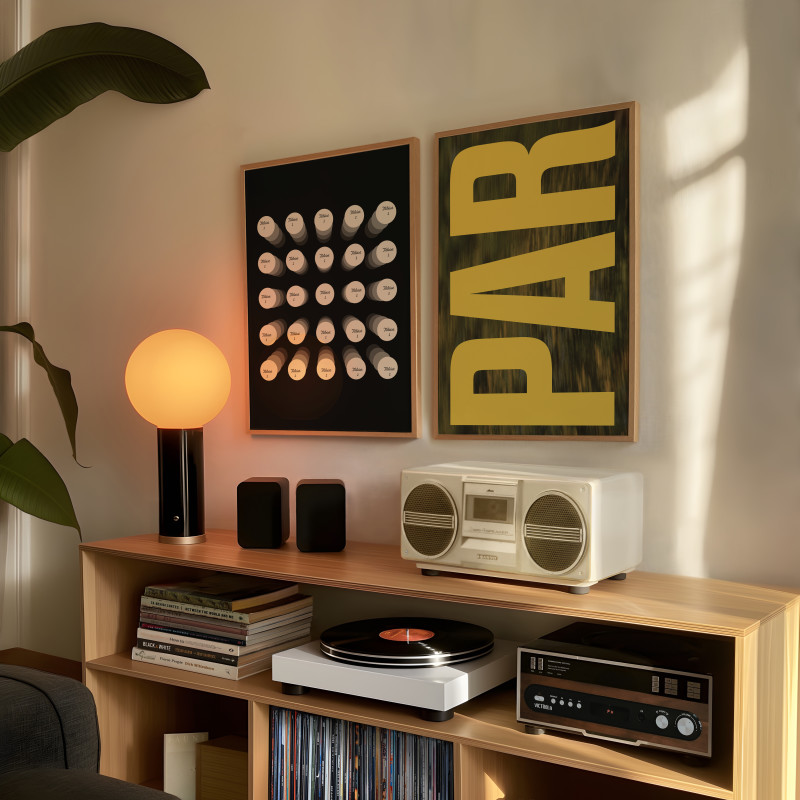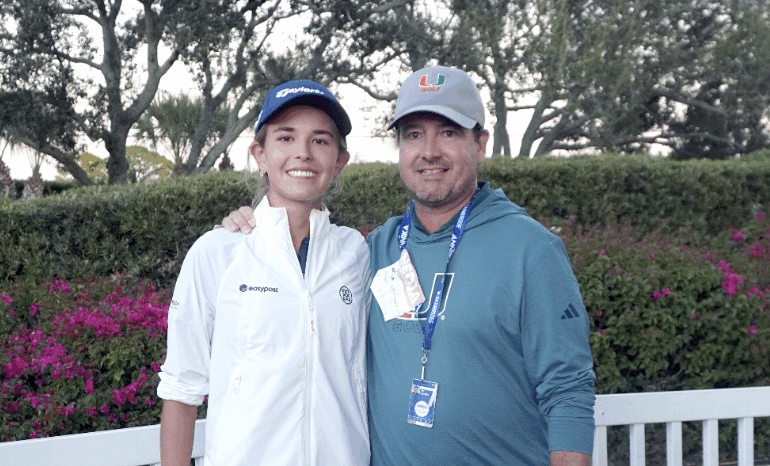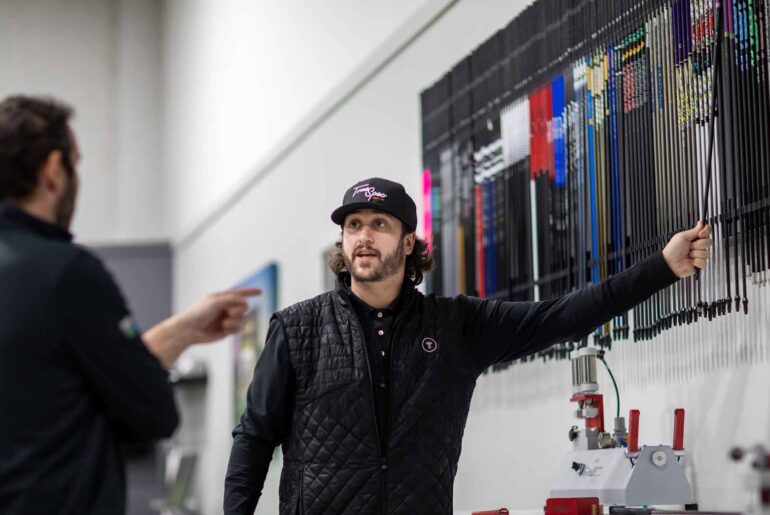This Economics Major Got Fed Up With Ugly Golf Art — So He Started a Revolution originally appeared on Athlon Sports.
Eric Woo had a problem. His workout room had this big blank wall, and he wanted to put up some golf art. Simple enough, right? Wrong. He spent hours online looking for something — anything — that didn’t look like it belonged in his grandfather’s country club. All he found was the same tired stuff: plaid patterns, crossed clubs from 1952 and those weirdly perfect green fairways that practically screamed, “You don’t belong here.”
“I searched everywhere, but everything felt off — too traditional, cheesy, or like something you’d find in a bargain bin,” Woo says.
That wall stayed empty for months. But his frustration was quietly evolving into something bigger.

Eric Woo, founder of Par x Design
Golf Got Cool. The Art Didn’t.
While Woo stared at his empty wall, golf was transforming around him. People in their 20s flooded public courses in Jordan sneakers and graphic tees. Instagram exploded with young players who treated golf like street culture, not country club tradition. The sport was shedding decades of stuffiness, attracting design-conscious players who valued authenticity over etiquette manuals.
Yet walk into any home goods store, and golf art remained frozen in amber — circa 1985.
Woo studied managerial economics at UC Davis, not art. He wasn’t supposed to care about design. But something about this gap in the market bugged him. Really bugged him.
“Around that same time, golf itself was shifting. It was becoming younger, cooler, more culturally relevant, but the art hadn’t caught up,” he explains.
“That’s when it clicked for me. There was a gap for golf-inspired pieces that belonged in a modern home. Not golf-themed art that felt cliché, but work that felt intentional, elevated and part of a bigger cultural movement.”
Death to Plaid and Polos
Woo launched Par x Design in 2024 with a simple mission: Kill golf’s visual clichés and build something better from the ashes.
“Golf has such rich history, but for a long time it’s carried an image of exclusivity, almost like it’s reserved for the affluent. I wanted PxD to flip that narrative,” Woo says. “Golf is so much more than the old stereotype. It’s fun, it’s relatable, and it teaches you life lessons no matter where you come from.”
His first designs were basically the opposite of everything else out there. Simple, clean fonts. Words like “BIRDIE” and “FAIRWAY” that looked like they belonged on a cool poster, not some cheesy golf store sign. People bought them up right away — they’d been waiting for this stuff forever.
Capturing What Golf Actually Feels Like
Woo wasn’t interested in making slightly better golf decorations. He wanted to bottle the actual experience of playing this maddening, addictive game.
“It’s one of those games that drives you crazy but you love every minute of it: the quiet morning rounds with strangers, the loud ones with friends, the small wins, and the endless pursuit of getting better,” he says. “That mix of frustration and joy, and that ‘if you know, you know’ energy, is exactly what we try to capture at PxD.”
The Elements Collection proves his point. Instead of depicting generic golf holes, these pieces capture moments every golfer knows: morning mist rolling across coastal fairways, desert sunrise painting the rough gold, mountain vistas that make you forget your terrible first drive. They’re unmistakably golf-inspired yet sophisticated enough for art lovers who’ve never held a club.
“I want someone to see a PxD piece and say, ‘That’s beautiful,’ whether they play golf or not,” Woo says.
Building a Movement, Not Just a Brand
Woo’s economics background taught him something crucial: Sustainable businesses create platforms, not just products. Rather than trying to design everything himself, he built Par x Design as a creative collective.
“We work with and support emerging artists, who each bring their own story and perspective. Elevating their voices not only creates fresh takes on golf, but also builds a platform where creativity and individuality can shine,” he explains.
This philosophy extends to Par x Design’s charitable partnerships. The company donates 5% of proceeds to First Tee, an organization breaking down golf’s economic barriers by introducing the game to kids from all backgrounds.
“I didn’t grow up in a country club environment, so golf wasn’t always accessible. First Tee is changing that by giving kids the chance to experience the game and the values it teaches, regardless of where they come from,” Woo reflects.
Learning Design the Hard Way
Transitioning from economics student to design entrepreneur meant becoming a student all over again. Typography fundamentals. Color theory. Print production logistics. E-commerce platforms. Customer service psychology. Woo learned by doing, making mistakes, iterating.
“The biggest challenge was starting from zero. I had no design background, just an idea I couldn’t shake. The surprise has been how quickly people connected with it from golfers and nongolfers alike,” Woo admits.
Social media became his classroom and his storefront. Woo’s genuine passion for both golf and design attracted a community hungry for something authentic. Sales grew through word-of-mouth — customers sharing pieces with friends who immediately “got it.”
Golf as Love Language
Woo’s relationship with golf began in his backyard with a plastic toddler set. Over the years, the game became his constant: a way to connect with his father, decompress during college stress, forge unexpected friendships with strangers who became lifelong companions.
“My first set was a plastic one in the backyard when I was a toddler. Golf was always something I could do with my dad, and over the years it’s become part of my identity. It’s given me incredible memories and introduced me to people I never would have met otherwise,” he says.
This authentic connection separates Par x Design from companies trying to capitalize on golf’s trendiness without understanding its emotional core. Woo doesn’t design for golfers — he designs as one.
From Empty Wall to Industry Revolution
Today, that workout room wall — once mockingly blank — showcases several Par x Design pieces. Each morning, they remind Woo how one moment of frustration sparked something much bigger than he imagined.
Par x Design now represents more than contemporary golf decor. It’s proof that fresh perspectives can transform entire industries, even ones as tradition-bound as golf. Woo took a sport stuck in visual amber and gave it the modern identity it deserved.
Golf’s visual revolution began with an empty wall and a UC Davis economics student who refused to accept boring art as inevitable. Now it’s changing how an entire generation of golfers sees themselves and their sport.
Related: A Golfer’s Paradise: Why Arnold Palmer’s Bay Hill Club and Lodge Remains One Of Golf’s Most Inspiring Destinations
Related: More Than Golf: Why the Folds of Honor Collegiate Represents Everything Right About College Sports
This story was originally reported by Athlon Sports on Aug 14, 2025, where it first appeared.







